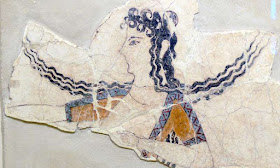A serious hint
in that direction was described by Maitland
Edey in his book “The Lost World of the Aegean” in the mid-1970’s and thanks
to a recent study we are most fortunate to obtain a confirmation of his theory through
modern DNA analysis.
Over the
centuries many theories have been elaborated and we are now able to establish
that both Minoan and Mycenaean populations originated in Anatolia
and moved west prior to the Bronze Age. The Minoans settled in Crete as early
as five thousand years ago while the Mycenaeans reached mainland Greece
DNA samples were
taken from the teeth of 19 remains that were positively identified as Minoans
from Crete, Mycenaeans from mainland Greece
and from people who lived in southwestern Anatolia .
Thorough analysis and study show that the Minoans and the Mycenaeans are
genetically very similar, although not identical and in the end, today’s Greeks
are descendants of these Anatolian populations.
Researchers were
even able to establish that the Minoans, Mycenaeans and modern Greeks are
related to the ancient people living in the Caucasus, Iran and Armenia Eurasia , whereas the Minoans are
missing this genetic part.
Greeks on the
mainland are somehow related to the ancient North Eurasians
and the people from the Eastern European steppe before and after the time of
the Minoans and the Mycenaeans. What’s more, modern Europeans also partially
belong to the ancient North Eurasians .
All this means,
that the Mycenaeans do not descend from a foreign population in the Aegean and that today’s Greeks do indeed descend from the
Mycenaeans. The peoples of the Greek mainland possess all the ingredients of
mixed ancient North Eurasians and Eastern Europe
genes both before and after the appearance of the Minoans and the Mycenaeans.
This may explain the relation of Greek speakers with their linguistic relatives
elsewhere in Europe and Asia . We are all one
big family!

No comments:
Post a Comment